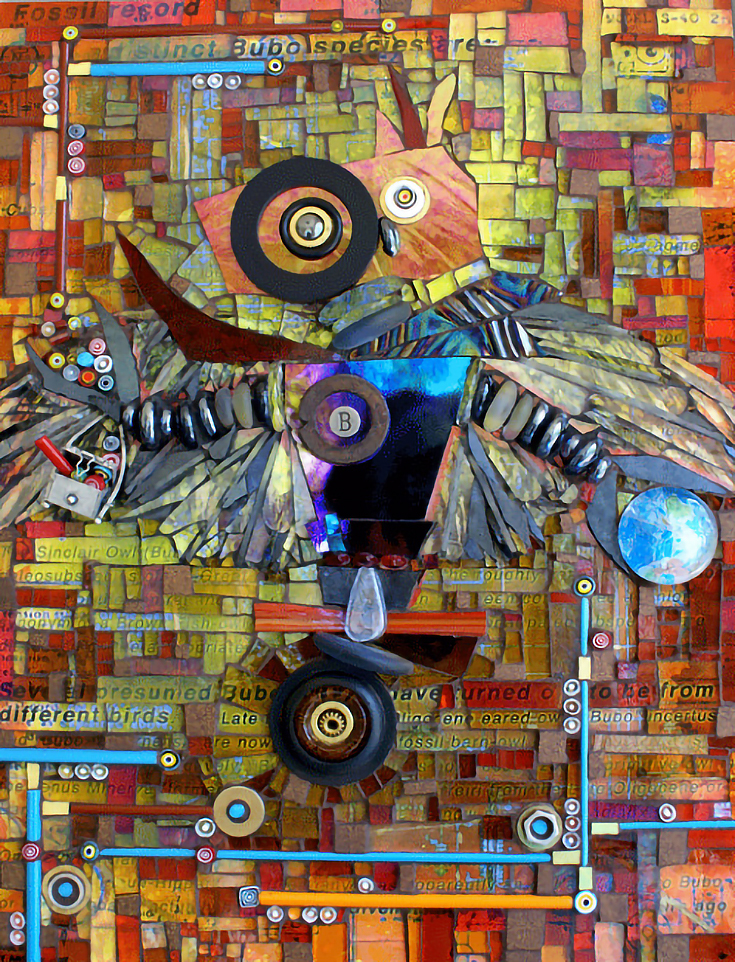 Rebecca Collins received a Bachelors of Fine Arts degree from the University of North Texas, with a concentration in jewelry and metalworking.
Rebecca Collins received a Bachelors of Fine Arts degree from the University of North Texas, with a concentration in jewelry and metalworking.
Since then, she has created artwork in all types of media including digital pet portraits and intricate mosaic art pieces.
Today I caught up with Rebecca and asked her a few questions about her artistic process, and her unique methods for mixing digital imagery with traditional glass pieces to create her one-of-a-kind digital glass mosaics.
Alyice: How did you get started creating mosaics?
Rebecca: In 2007 I took a mosaic class at the Creative Arts Center here in Dallas as a distraction from my day job of creating digital portraits. I love the commercial artwork that I do for my company, Art Paw, but I wanted to get off the computer and get my hands dirty again. I was hooked right away and within a year I was showing at local art events and galleries.
Alyice: There’s a lot of mosaic art on the market these days, how do you differentiate yours from the rest?
Rebecca: I have a mixed media approach that combines my own digital art collaged underneath the glass mosaic work. Very few people that work with mixed media mosaics have the ability to build up the collage layer in the same way that I do using the computer and original digital drawings underneath the glass work. I also combine watercolor and acrylic paint on the collage layer.
Alyice: A lot of your pieces carry a message. Why is it important for you to use words in your pieces?
Rebecca: I love using text in my work and spend time selecting a few word-bits to show up well, leaving the majority of the text to serve as a visual texture.
I have always used text in collage work and enjoy the random humor that can come about when words are isolated in context. I think the text is well suited for mosaic work since everything is pieced together like a puzzle. I am always fine with the fact that much of the text will be hidden or slightly lost beneath the layers of paint and glass. My hope is that when people do take the time to try and read some of the text it will make them smile.
Alyice: Do you ever create in themes? If so, what draws you to a theme and how do you go about assembling the pieces?
Rebecca: I do tend to work within themes and can get stuck on one subject for a year or longer.
I am drawn to subjects that are a bit quirky and non-traditional for mosaics. Right now, I am exploring Robots and I really enjoy creating them because they can be anything and they can be recreated in hundreds of ways.
As far as the creative process goes… lately I have been experimenting with a wide variety of media from ceramics to digital sketches. I like to play around with different media and then return back to mosaics refreshed and ready to work.
My mosaics almost always start out as a digital sketch. Things change along the way as I start playing with materials and I seldom can visualize the piece from start to finish, there are always surprises. I often will research things on-line to give my robots an inner story that I am really the only one that knows. Sometimes this research will show up within the random text.
Alyice: What is the most challenging part about working with mosaic pieces?
Rebecca: For me, it is balancing the collage elements that I create with the glass.
It is important for me to have the cutting and placing of the glass be as important as the artwork beneath the glass. I never want it to appear that I am just covering up a cool collage with glass. It is a back and forth process that I am always trying to perfect.
It can get difficult if the artwork in the background is too busy and I have to often think very hard about my cuts so that the stuff that I want to show through will in fact read with the glass on top.
Alyice: What is the best part about working with mosaic pieces?
Rebecca: It is the meditative feeling you get from the slow process really. It is very calming. My commercial portraiture work must be done on demand and quickly to meet gift-giving deadlines, while the mosaic work that I do for myself takes time, and can not be hurried.
Alyice: When creating your mixed media mosaic pieces, you use a lot of material not customarily seen in mosaic art. How much of a challenge is it to incorporate these various pieces?
Rebecca: Larger pieces can be applied with thinset when needed, however, most of the mixed media elements I use are applied with weldbond glue; which is a very strong adhesive.
The real challenge with chunky elements is the design challenge of using additional chunky tesserae along side it so that there is a nice transition from flat thin glass to the bigger objects. Occasionally I will have elements that hang off of the board in front of the piece and in these cases I do have to get tricky in figuring out the support hardware.
Alyice: For those interested in trying mosaic art, what’s the safest way to cut stained glasss, porcelain, and the various materials used in mosaic art?
Rebecca: The best way to cut sheet glass is with scoring and breaking tools. Once the glass is broken down into smaller strips you can use wheeled nippers to cut the glass into desired shapes.
You always need to wear protective eye wear and be careful when cleaning your work table. Most of the cuts I get are when I am sorting through glass or cleaning my table, I rarely cut myself when working directly with the glass.
I studied in Italy last year and learned to cut thick Smalti with the hammer and hardie. The hardie has a chiseled edge and is traditionally mounted on a log.
Alyice: As you know, art is very subjective in nature. How do you handle the negative criticism, especially when it hurts deep down within your soul?
Rebecca: I really have pretty thick skin at this point in my career. Because I do commercial artwork for a living I am very accustomed to clients requesting design tweaks and I have learned that everyone has different tastes.
I am a bit more sensitive about my personal mosaic work however so I try to focus on my successes and avoid negativity.
Artists are very sensitive as a rule, and the first step to really becoming a fulltime professional artist is learning to deal emotionally with criticism.
The important thing is to really hear the “constructive” criticism and value it so you can learn from it. Negative criticism that is just hateful in nature, well you have to just let go of it because life is too short.
Alyice: What’s the coolest art tip you’ve ever received?
Rebecca: The best art tip I have ever received is from my husband, about people who copy your ideas or your style. He told me that people who copy can never lead, and that I just need to keep creating and strive to be a leader, staying way ahead of the imitators with new ideas and new work.
That advice has helped me so much. . . too many artists live in fear of being copied, and then when it happens it feels like a knife in your gut. But you just have to keep creating and know that you will never run out of ideas.
You can learn more about Rebecca at her website, RebeccaCollins.com.
This post may contain affiliate links.



